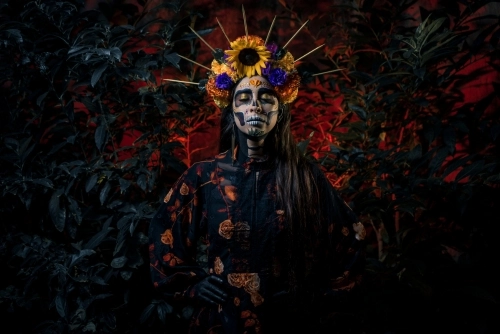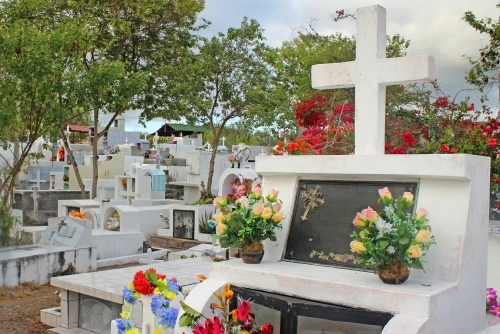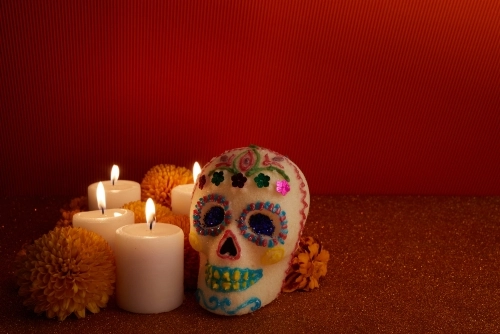I’d bet you didn’t know that Cinco de Mayo is more widely celebrated in the…
Día de los Muertos (Day of the Dead) History, Traditions, and Costumes
Día de los Muertos, otherwise known as Día de Muertos or Day of the Dead (in English), is a holiday that takes place on November 1st and 2nd throughout Mexico and by many people of Mexican heritage around the world.
A beautiful celebration of the circle of life and death, it is also observed in a few other Latin American countries including Guatemala, Bolivia, Chile, and El Salvador. Day of the Dead is often assumed to be another version of Halloween, but that couldn’t be farther from the truth. Join our English to Spanish translation professionals as they uncover the roots and celebration customs of Día de los Muertos in this post.
Where Does the “Day of the Dead” Have Its Roots?
Día de los Muertos originated in ancient Aztec culture dating back to the 7th century and has grown to be a widely celebrated international holiday. It is a very important occasion for millions of people around the world, allowing people to honor their departed loved ones while celebrating life.
Día de los Muertos: The History and Meaning
It all begins on November 1st, Día de los Angeles, or Day of the Angels, which is a day that commemorates children who have passed away. On Día de los Angeles many friends and family clean the deceased children’s headstones with flowers before placing down candy and toys and decorating them with colorful marigolds and lighting candles, both of which are said to guide them through the darkness of night to Mictlan, the Aztec land of souls. On Día de los Angeles, it is believed that the angels come to Earth from Mictlan to visit their families just as they would during Día de los Muertos. For this reason, many friends and family members dress up as angels and celebrate Día de los Angeles by bringing an assortment of sentimental gifts and performing dances in honor of their child’s memory.
It is believed that Día de los Angeles was moved to November 1st on purpose, so children who have recently passed could attend the celebration with their families without anyone missing them. Día de los Muertos has become a two-day holiday, with Día de los Muertos celebrated on November 2nd following Día de los Angeles.

Día de los Muertos honors deceased adults through various festivities such as dancing, wearing costumes, and visiting cemeteries to picnic and celebrate life with the souls of their lost loved ones.
Day of the Dead Celebration
Día de Muertos usually begins with a vigil and ceremony at the family’s home, and it is pretty much expected that everyone—regardless of age or cause of death—will come together to celebrate life.
Día de Muertos allows people to celebrate those who have died as well as those still alive by telling stories about them, visiting the gravesites of those they love, and creating altars dedicated to those they have lost which are filled with their favorite foods, drinks, and photographs. Participants dance and wear colorful costumes to disguise themselves as spirits or “Catrinas” as they visit cemeteries at night to picnic and light fireworks. It doesn’t stop there though.
On Día de los Muertos, people clean up the gravesites of their loved ones by replacing any wilted flowers with fresh bouquets. The altars are one of the centerpieces of the celebration, and they are usually decorated with marigold flowers.
Food plays a special role, believed to represent each soul who is being honored. For example, an Aztec sandwich is made of two pieces of bread with un-melted cheese in between them because it is believed that the souls are still learning how to be happy and see the good side of life. Each element has a special meaning. The candles represent light whereas water signifies nourishment. Salt is synonymous with purification, ash signifies death, fire represents warmth, incense cleanses the spirits, and apples pretty much always signify temptation (Thanks, Adam & Eve).
Day of the Dead: Not Your Average Halloween
Many folks tend to confuse the two, but the truth is, it isn’t a matter of either/or—many people celebrate both Halloween on October 31st, and Día de los Muertos on the days following. Both serve unique purposes and are observed with very different traditions.
Halloween was originally a pagan celebration meant to honor the dead. In Mexico, this holiday is referred to as Día de las Brujas and is mainly regarded as a day for festivities for children.

The Mexican people have also taken parts of Día de los Angeles and incorporated them into their Halloween celebrations which they refer to as Todos Santos. Todos Santos is one night during which it is believed that the souls of those who have passed on may return to earth. On Todos Santos, children or adults dress up like Catrinas or angels to disguise themselves as spirits—some will even wear masks made out of pumpkins!
On October 31st, they clean up the gravesites of loved ones and replace wilted flowers with fresh bouquets. The family’s home is also decorated to welcome any spirits who may return.
There is one more holiday to take note of: The day before Todos Santos—October 30th—is called Día de los Inocentes which translates to Day of the Innocents in English. On this night, people of Mexican descent visit the gravesites of loved ones dressed like Catrinas and light candles for them, commemorating those who have passed away and honoring their memory.
Day of the Dead Costumes
You’ve probably seen images of the striking costumes and makeup associated with Día de los Muertos, but what exactly do those costumes represent, and why are they worn?
These colorful costumes, often depicting calacas (which translates to skeletons in English), serve as a symbolic way to celebrate life and honor loved ones who have passed away. These costumes, adorned with intricate designs and vibrant hues, aim to evoke joy and celebration rather than fear, reflecting the belief that death is a natural part of the human experience, channeling loved ones and honoring their life. Rather than scary or macabre costumes associated with Halloween in America, Día de los Muertos costumes are a joyful tribute to the enduring connection between the living and the departed during this sacred and festive occasion.
Participants, both young and old, don costumes to join processions, visit cemeteries, and partake in festivities, creating a lively and communal atmosphere that blends cultural reverence with artistic expression.
One of the most popular Day of the Dead costumes is Calavera Catrina, or “The elegant skull”, popularized by a zinc etching made by Mexican printmaker and lithographer José Guadalupe Posada in 1910—though La Catrina’s actual origins date back to the Aztec figure Mictecacihuatl, the death goddess of Chicunamictlan. This costume usually includes a long, flowing dress, often in brightly-colored lace, along with colorful makeup and a crown of flowers.
Day of the Dead Makeup
Dia de los Muertos sugar skull makeup, or “calavera de azúcar,” is a central and iconic element of the Day of the Dead celebrations, serving as a visually striking tribute to departed loved ones. The makeup typically involves intricate designs, often resembling decorative sugar skulls—made from sugar or clay and intricately decorated—used in the holiday’s rituals. Adorned with vibrant colors, floral patterns, and symbolic elements, these designs honor the lives of the deceased. Each embellishment, from floral adornments to geometric patterns, holds symbolic significance, turning the act of applying sugar skull makeup into a deeply meaningful and artistic expression of love, remembrance, and cultural heritage.
Day of the Dead Barbie
In 2019, Mattel made headlines with their Day of the Dead Barbie. Only 4 years later would the world learn that Mattel would release the Barbie movie, gross over $1.4 billion, and release iconic Barbie dolls again. We digress. The Day of the Dead Barbie is now priced at $75 and features an elegant mermaid-style black dress adorned with monarch butterflies, marigolds, and roses. Her face is embellished with Calavera Catrina makeup, and atop her head sits a crown adorned with marigolds. While the doll includes features that do fairly accurately reflect the costume and makeup commonly associated with Día de los Muertos, it still caused a bit of a stir: public opinion was mixed, with some appreciating it as a representation of cultural diversity and others critiquing it for potential cultural appropriation or commercialization of a sacred tradition.
Cinco de Mayo vs Día de Muertos
Día de los Muertos and Cinco de Mayo are two distinct Mexican celebrations that have become more widely celebrated with each passing year, yet they hold very different cultural and historical significance.
Día de Muertos, or Day of the Dead, is a Mexican holiday dedicated to honoring and remembering deceased loved ones. Cinco de Mayo, on the other hand, observed on May 5, commemorates the Mexican army’s victory over the French at the Battle of Puebla in 1862. While widely celebrated in the United States to honor Mexican culture, it is not Mexico’s Independence Day, as commonly believed—that falls on September 16.

Cinco de Mayo often features parades, music, dancing, and culinary festivities, showcasing Mexican pride and heritage.
Utilize Our English to Spanish Translation Services in Raleigh
Whether you’re interested in celebrating the Día de Muertos but don’t know where to start, or you want precision translation services for personal or business use, we can help! At English to Spanish in Raleigh, our translators are happy to accommodate your budget, timeline, and needs to get the results you need. We provide professional translation services at an affordable price point. To get started, give our translators a call at 919-629-0020 or fill out the form below.
Contact a Translator
Talk with a native Spanish-speaking translator about your next translation project.
Related Posts
- Cultural Relevancy Case: Cinco de Mayo celebrated more in US than Mexico
- Acción de Gracias: How Latinos Celebrate Thanksgiving
Thanksgiving isn’t typically celebrated in Spanish-speaking countries, but celebrations of family, food, togetherness, and thankfulness…
- Day of the Dead Differs From Halloween, It's True
Though the festivities begin on October 31st, the Day of the Dead has nothing to…
